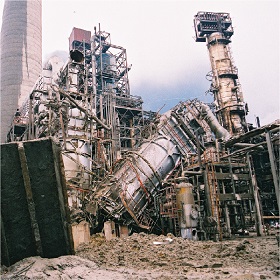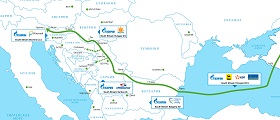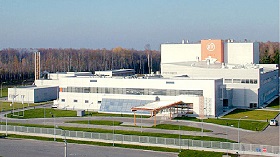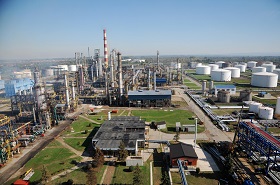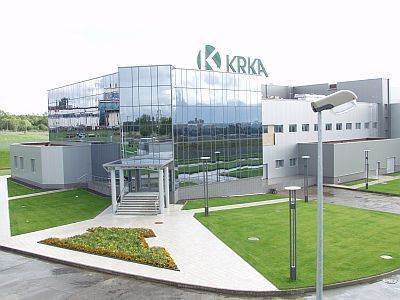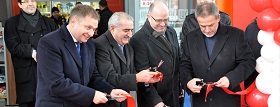Modern Russia in the Modern Balkans: Soft Power through Investment
Welding first joint of Serbian section of
South Stream gas pipeline
(votes: 2, rating: 5) |
(2 votes) |
Ph.D. in History, Senior Research Associate, RAS Institute of Slavonic Studies
Having faced a certain de-intensification of relations with the countries of Central and South-Eastern Europe in the 1990s, Russia in the 2000s began to restore its presence through economic tools, such as investment. As a result, Russia in the 2000s established a special relationship with each country in the region, which we will try to describe as we identify Russia’s place in the Balkans today.
Having faced a certain de-intensification of relations with the countries of Central and South-Eastern Europe in the 1990s, Russia in the 2000s began to restore its presence through economic tools, such as investment. The Western Balkans (former Yugoslavia) happened to be one region where this was particularly intense. This region was selected for a number of reasons, namely weak local economies resulting from the events of the 1990s (war and the transition from socialism to a market economy); the region’s traditional historical and geostrategic importance for Russia; the country’s largely benevolent attitude toward Russia, which is regarded as a rich country inhabited by people from a related culture who are well-off and have money to spend (despite the average living standards in our country). All this, however, was counterbalanced by the local elites, which took a different view. As a result, Russia in the 2000s established a special relationship with each country in the region, which we will try to describe as we identify Russia’s place in the Balkans today.
The six republics of the former Yugoslavia analyzed in this paper can be divided into three groups. Serbia, which has historically enjoyed a “special relationship” with Russia, can undoubtedly be called a traditional Russian partner. Montenegro can be placed in the same category, but with certain reservations. The nature of investment there is somewhat different, as it is corporations that invest in Serbia, while it is individuals who invest in Montenegro (chiefly in real estate and tourism); Montenegro’s foreign policy is more Western-oriented; and a number of large investment projects have failed.
Bosnia and Herzegovina may be called prospective partners, especially one of the two entities of the Federation – Republika Srpska – and Macedonia. Large Russian capital arrived relatively recently (2007-2012), but its prospects are good thanks to the countries’ geographically fortunate position (linking the “north-east – south-west” and the “north-west - south-east” routes) and the population and current political establishment’s favorable attitude. Russian companies also have major business interests there.
Slovenia and Croatia can be viewed as potential partners. Although Russian projects have not yet charted particular successes, these countries may find Russia an attractive alternative to their current western partners due to the EU’s economic crisis. Slovenia is already realizing this, and Croatia may follow suit in 2-4 years.
Regional investments also play a role. In summer 2012, Sberbank paid 600 million euros for the Eastern European branch of Volksbank banking group, thus acquiring a network in Slovenia, Croatia, Bosnia and Herzegovina and Serbia.
Traditional Partners. New Opportunities
Serbia
In 2003-2012, Russia has invested at least $2.85 billion in the Serbian economy. In 2003, Lukoil pioneered Russian investment in the country by paying 117 million euros for a 79.5 percent stake in Beopetrol (the company's main activities include the retail and wholesale trade in oil and oil derivatives) and its network of 180 filling stations. This made Lukoil the second largest supplier of oil products in the country and a potential regional leader.
In 2008, Gazprom entered the Serbian market. On December 24, 2008 Gazprom Neft acquired a 51 percent stake in NIS (a Serbian multinational oil and gas company – Petroleum Industry of Serbia), and by 2013 increased its stake to 56.15 percent. Gazprom now enjoys control over refineries in the cities of Pancevo and Novi Sad, a retail network of 500 filling stations and other businesses in Serbia, the Balkans, as well as Hungary, Romania, Turkmenistan, Angola, Belgium and Russia. At the same time, the start of construction work on the South Stream Pipeline's Serbian Section was announced. The joint venture South Stream Serbia AG was established for this purpose in November 2009 (Gazprom holds a controlling 51 percent in the company, while Srbijagas owns 49 percent) and the Banatski Dvor gas storage facility was modernized.
It is worth noting that Lukoil and Gazprom (as well as Zarubezhneft in Republika Srpska) acquired businesses that had suffered severe damage during the war and economic turmoil of the 1990s. In 1999 NATO bombings almost completely destroyed refineries in Novi Sad and Pancevo. Russian investment helped save these dying giants of Yugoslav industry, breathed life into the region’s economies and created new jobs (the South Stream project in Serbia will create 2,500 jobs). Russian companies received processing facilities (refineries, gas storage centers) in Europe, making this “soft underbelly” the central element in its EU energy exports scheme.
Russian investments in the energy sector should create a platform for development in other areas. On May 24, 2013 Russia and Serbia signed the Declaration on Strategic Partnership. Serbia’s Hemofarm (pharmaceutical products) and Sintelon (synthetic flooring) have business interests in Russia. Serbia is courting Russian investment in 71 projects (in metalworking, chemical and electrical industries, construction, and agriculture). Russia may be interested in developing Serbia’s spa and mountain resorts (Zlatibor, Kopaonik, Stara Planina), while the Serbian side, which participated in the construction of Olympic facilities in Sochi, is interested in gaining access to FIFA World Cup 2018 projects.
According to optimistic estimates by the President of Serbia’s Chamber of Commerce and Industry Željko Sertić, the value of potential joint projects is estimated at $7 billion, while the expected income could exceed this figure by at least a factor of five.
Despite this potential, Russian investment could encounter difficulties, primarily of a political nature. Although Belgrade officially recognizes South Stream’s importance for Serbia, the project is criticized by some members of government, in particular former Minister of Energy, Development and Environmental Protection, Zorana Mihajlović. She became known not only for her public statements, but also for the attempt in 2012 to substitute the final text of a Russian-Serbian gas agreement at the signing ceremony with a different one that excluded one of the Russian participants. Although Mihajlović’s critical outbursts somewhat subsided after the meeting between Russian President Vladimir Putin and Serbian President Tomislav Nikolic (October 31, 2013). These facts, coupled with the obvious differences in the executive branch, testify to a serious political struggle and suggest that the ex-minister is playing into the hands of certain forces that oppose Russia’s return to the Balkans, which is currently taking place in the energy sector.
Russian experts’ forecasts should be viewed in this context. They believe that after reelection in March 2014, Serbia’s government of Aleksandar Vučić may attempt to nationalize Russian assets for their subsequent transfer to Western corporations and lobby for the implementation of the Third Energy Package program in Serbia, which also runs counter to Gazprom’s interests. These forecasts take on particular relevance in relation to Russia's decision to file suit in the WTO against the EU’s Third Energy Package. There is a possibility that Serbia, interested in joining the EU, will be forced to abide by Brussels’ recommendations, expressed in December 2013 by the European Commissioner for Energy Günther Oettinger, and divide Serbiagaz into sales and gas transportation companies, and transfer part of its shares to third parties.
JSC Russian Railways’ (JSC RZD) projects in Serbia also deserve consideration. On January 11, 2013 an agreement on providing Serbia a loan of $800 million was signed. This money formed part of the $941 million advance payment, which the Serbian government allocated to Russian Railways International (a Russian Railways subsidiary established in December 2012) for rebuilding Serbia’s railway system (February 12, 2014). Work began on March 26, 2014. Russian Railways plans to modernize a total of 350 km of railways, including 200 km of the Belgrade-Bar (Montenegro) line, and supply Russian locomotives to Serbia.
This agreement carries immense significance. It is the first major Russian project in the region that is not related to energy. This is even more valuable in the light of Aeroflot’s abortive attempts to purchase shares in the national airline JAT [1]. Serbia is one of the few countries outside Russia, and the first in Europe, in which Russian Railways operates. If successful, Russian Railways may enter into contracts with other countries in the region that have obsolete railway infrastructures, similar to that in Serbia.
Montenegro
Russia is the leading state responsible for investment in Montenegro. In 2001-2010 it invested 568.3 million euros (Italy is the second largest investor, with 491.5 million euros). According to estimates by the German Institute for International and Security Affairs (SWP), in 2010 32 percent of enterprises in the country were owned by Russian businessmen.
Russian investment in Montenegro has its particular features. First, it tends to be individual and recreational, rather than governmental or industrial. This is due both to the lack of major industrial enterprises in Montenegro and its remoteness from major transit routes, as well as to setbacks that have plagued Russian investors. Suffice it to recall two examples: the frozen construction of the Mirax hotel complex and Oleg Deripaska’s purchase of the aluminum plant in Podgorica. If the first failure resulted from the 2008 economic crisis, the second undoubtedly resulted from a misunderstanding with the Montenegrin authorities.
The investment objects are small – chiefly comprising basic real estate, hotels, cafes, and restaurants. Montenegro attracts Russians thanks to its agreeable climate, friendly locals, similar culture, and cheap accommodation and real estate (this last was more relevant for the first half of the 2000s). It is also important that Montenegro is a tax haven with Europe’s lowest income tax (9 percent) and liberal legislation.
According to the head of the Ethnographic Institute at the Serbian Academy of Science and Arts Dragana Radojičić, in 2006-2009 Montenegro chiefly attracted members of the intelligentsia and middle classes (scientists, physicians, businessmen, artists, and journalists) [2]. However, in recent years, the mass media has contributed to promoting an entirely different vision of Montenegro as a “Russian colony” where the main purchasers of real estate are people close to Russia’s political elite, who intend to influence political decision-making in the Montenegrin state. The Russian capital is said to own “too much” Montenegrin property and the citizens are allegedly intimidated by the threat of economic collapse that would follow massive capital outflow.
These allegations do not hold water, not least because of political and social heterogeneity of the Russian community in Montenegro. But Montenegro’s joining anti-Russian sanctions in connection with the situation in Crimea could give new impetus to these sentiments. It is worth noting that Montenegro’s Prime Minister Milo Djukanovic paid lip service to the sanctions and confirmed the country's intention to join the EU and NATO. All this is unlikely to threaten ordinary Russian citizens, but it creates an unfavorable background for further strategic investments in the near future.
Prospective Partners. Regional Risks
Republika Srpska (Bosnia and Herzegovina)
Zarubezhneft, its subsidiary Neftegazinkor, and the Russian-Serbian oil and gas company NIS (Petroleum Industry of Serbia) all operate in Republika Srpska. Private investors are involved in modernizing thermal power plants and developing coalfields in Ugljevik (the total project value is one billion euros). On September 21, 2012 Republika Srpska joined the South Stream project.
According to Sarajevo’s official data, by September 2012 the volume of Russian investment in Bosnia and Herzegovina amounted to 760 million euros. The main assets are located in Republika Srpska (RS), namely oil refineries in Bosanski Brod and Modric bought by Zarubezhneft in 2007. RS Prime Minister Milorad Dodik was personally involved in talks with the corporation [3]. The importance of this deal is hard to overestimate. Russian investment (according to some sources, investment in modernizing enterprises is expected to reach 750 million euros by 2015) delivered renovated enterprises and saw life return to depressive cities. Revenues from production helped strengthen RS’s political power, gain economic independence from the central government in Sarajevo and the High Representative for Bosnia and Herzegovina, appointed by the international community under the terms of the Dayton Accords. Zarubezhneft has acquired two powerful enterprises in the Balkans, a prime location that allows Russian crude processing for further delivery to the EU markets [4].
Cooperation is also developing in non-hydrocarbon sectors. In 2013, Republika Srpska opened a Representative Office in Russia. Comprehensive information regarding investment in the Republic can be found on its website. According to the Head of the Representative Office Duško Perović, Russia increased its presence in Republika Srpska by 40 percent in 2013 alone. Attracting RS companies to operate in the Russian regions, particularly in Nizhny Novgorod, is also proving quite successful.
Possible restrictions on autonomy by officials in Sarajevo pose a potential threat to Russian investment in the Balkans [5]. However, despite this 18-year threat, Republika Srpska has managed to strengthen its position and develop, thanks in part to Russian investment. The general election in fall 2014 in Bosnia and Herzegovina and Republika Srpska will be a decisive factor shaping investment prospects. If President Milorad Dodik and his party (Alliance of Independent Social Democrats SNSD) manage to retain power, the next four years will be an opportune time to invest in Republika Srpska.
Federation of Bosnia and Herzegovina
Russia is also interested in the other part of Bosnia and Herzegovina, namely the Muslim-Croat federation. Since 2010, NIS and Zarubezhneft have been carrying out geological explorations in the region [6]. In 2013, the companies took over Austrian oil and gas group OMV’s filling stations (1, 2). Meanwhile, Sberbank has appeared in Bosnia and other countries of the region.
On May 30, 2013 the Russian Federation’s Chamber of Commerce hosted a forum “Business cooperation with Bosnia and Herzegovina”, the first of its kind, and At the first agreement on a visa-free regime was signed. Minister of Foreign Affairs in Bosnia and Herzegovina’s Council of Ministers Zlatko Lagumdžija came to Moscow to participate in these events [7]. They were obviously aimed at arousing interest in the Federation as a whole, but to date problems dominate the picture.
Russia and Bosnia and Herzegovina have no agreements on mutual protection of investment and double taxation. There is no bilateral free trade agreement. There are no direct flights from Moscow to Sarajevo (Moscovia announced plans to launch this route last year, but abandoned the idea several months later). In February, Bosnia and Herzegovina faced a wave of social protests as well as appeals to revise the constitutional order. Under these circumstances, further rapprochement appears to stand little chance of success. Russia has already found a partner in Republika Srpska, and Sarajevo’s interest in Moscow will depend on the ability of its main investors, namely Austria, Croatia, Slovenia, and Turkey, to support the Bosnian economy. Meanwhile, the Turkish presence in Bosnia and Herzegovina, as well as that of Arab countries is gaining momentum (1, 2).
Macedonia
Much like Bosnia and Herzegovina, the Republic of Macedonia (RM) is heavily associated with political instability, largely caused by the “Albanian factor.” However, despite political tensions, complex administrative system and ethnic composition (64 percent Macedonians, 25 percent Albanians) and its remoteness from the sea, the country has a stable economy (inflation is at 2.8 percent and annual GDP growth is at 3.2-3.4 percent), strong national currency, and a good investment climate.
In 2012, Russia and Macedonia signed an agreement on a visa-free regime, and the opportunities offered by the country gained a presence in the Russian information space. Despite the ensuing surge in interest, the countries saw turnover fall from $151 million in 2011 to $75 million in 2013 Investment, however, was on the rise. According to the People's Bank of the Republic of Macedonia, Russian direct investment in the country amounted to 12.04 million dollars, many times more than in previous years. Most investment ($8 million) was made by Russia’s Protek Group, a pharmaceutical company, which is building a new plant in Skopje. Lukoil has operated a network of 25 filling stations in the country since 2005; and there is an agreement on Macedonia’s joining the South Stream Project. Promising fields of investment include agriculture, light industry, and religious tourism (Ohrid region). Given the country's prime location at the crossroads of the southern Balkans near Italy, Turkey and the North African coast, the development of a railway or air hub in Skopje would seem viable.
Potential Partners
Slovenia
By the end of 2011, Russian direct investment in Slovenia amounted to 90.7 million euros. The largest purchases are the Russian company Koks’s 16.86 percent stake in the Slovenian metallurgical holding SIJ and a Russian investor’s majority stake in the tourism company Terme Maribor.
During the same period (end of 2011), Slovenian investment in the Russian economy amounted to 336.1 million euros: Russia ranks fourth in terms of Slovenian direct investment abroad [8]. This investment includes the pharmaceutical plant Krka-Rus in the town of Istra and the paints and varnishes enterprise Odilak (part of Slovenia’s Helios Group) in Moscow suburb Odintsovo. Agreements on trade and investment cooperation between Slovenia and the Yaroslavl and Samara regions were also signed). Engineering firm Riko also announced plans to build a plant in Russia.
Given the pre-crisis state of its economy, Slovenia is interested in Russian investment, something that is clearly evidenced by the movements of the country’s Foreign Affairs Minister Karl Eryavets [9]. The past four years saw nine visits at president and prime minister level, and 60 documents were signed. On December 10, 2013 Prime Minister Dmitry Medvedev stated at a meeting with his Slovenian counterpart that “the total volume of Slovenian investment in Russia exceeds Russian investment in Slovenia”, and noted that the Russian side should take advantage of the numerous opportunities it has at its disposal.
A major sale of Slovenian assets is expected in the near future. The Government intends to sell a 74-percent stake in national carrier Adria Airways, a 64 percent stake in Ljubljana airport, 32.6 percent of the chemical manufacturer Aero, 82 percent of Credit Bank Maribor, 72 percent of Telecom Slovenia, 11 percent of Cinkarna Celje (chemistry and metallurgy), and 71 percent of the paper mill Paloma. The full list of companies can be found on the Slovenian Agency for Investment’s website. If Russian investors find these deals sufficiently attractive, the country could gain access to the interesting technologies that Slovenia boasts in a number of areas (renewable energy, telecommunications, tourism, construction and engineering, pharmaceuticals and food industries). Russia could gain further entry to the European market and marketing outlets in the Balkans, as well as a loyal partner in the EU, which Ljubljana is beyond any doubt.
Croatia
Although Russia has been one of Croatia’s traditional trading partners since the Yugoslav era [10], this has little impact on the investment in the country. Each Croatian state leader emphasizes the desirability of Russian capital inflow, but from 1993 to 2011 it amounted to just $230.8 million, which bears no comparison with Russian-Serbian cooperation.
Russian-Croatian economic relations experienced an uptick in development in 1999-2008, when turnover increased significantly (soaring to $3.2 billion), and Russia became one of Croatia’s top three trade partners [11]. Energy products form the basis of Russia's exports to Croatia, just as they do to other Balkan countries. However, this does not mean that Croatia was not interested in Russia-produced high-tech products. In 2008, as part of the USSR/Yugoslavia debt repayment framework, Russia delivered Mi-17Sh military transport helicopters worth $65 million to Croatia, in addition to equipment for the Sisak thermal power plant [12].
In the 2000s, several major projects failed for a variety of reasons. They include the failure of the Druzhba (Russia) and Adria (Croatia) pipeline integration plan [13] and the purchase of metallurgical works in Split and Sisak by Truboimpeks and Mechel (2001, 2003 and 2007) [14]. Russian billionaires Evtushenkov and Abramian suffered major setbacks when they parted with significant sums to purchase land on the islands of Mljet and Krk, only to fail to obtain building permits, due to the peculiarities of Croatian legislation (of which they apparently had not been aware). Zarubezhneft recently revealed its intention to organize oil product transit to Western Europe through Croatia, but no progress has yet been seen [15].
The reasons for these failures are as follows:
- Unattractive investment climate; the existence of significant administrative barriers; intricate state and local legislations.
- Lack of political will on Croatia’s part; negative coverage of Russian investment initiatives by the Croatian media. According to Russia’s Ambassador to Croatia Robert Markarian, this has manifested itself in the cases of Druzhba-Adria integration, Mechel and Zarubezhneft.
- Russian investors’ poor knowledge of Croatian specifics, as illustrated by Mechel’s purchase of the Zhelezara Split factory in 2003-2004 [16].
Consequently, examples of successful investment can be counted on the fingers of one hand. The Russian-Croatian refinery Komicro has been functioning since 1993.
Lukoil is also present in the country and has a network of 48 gas stations and oil terminals in the towns of Vukovar and Omišalj. Of course, there are examples of Russian purchases of houses, restaurants and hotels, but this relates more to private rather than public investment.
It seems that opportunities for developing economic relations between Russia and Croatia have, to an extent, been missed. This is evidenced by the decrease in turnover to 1.73 billion euros, from 2009. In 2013, Croatia joined the EU, and the next few years will focus its trade relations in that direction. Nevertheless, there are grounds to revive economic links with Russia. They include:
- Maintaining stable relations in the strategically important shipbuilding industry. From 1993 to 2009, Croatian shipyards in Rijeka, Pula, Trogir, and Split built 41 vessels for Russia with a freight-carrying capacity of 1.58 million tons (tankers, bulk carriers, chemical tankers, and floating docks). In September 2009, Croatia’s Yadranbrod and Russia’s United Shipbuilding Corporation signed a new long-term cooperation agreement.
- The example of Slovenia, which is seeking to develop relations both with the EU and with the Russian Federation.
- Croatia’s joining the South Stream Project (under an Intergovernmental Agreement signed on March 2, 2010).
Perhaps Russian investment in Croatia requires the creation of certain conditions that would allow Croatian exports and investment in Russia to increase. Currently, Russian exports account for 75 percent of our common turnover, which the Croatian side is unlikely to view positively. Croatian products have not find a prominent place on the Russian market for numerous reasons, including poor brand recognition, quality issues, insufficient export volume, and Russian importers’ continuing interest in West European products.
The project’s successful realization is fraught with potential risks for Russian-Croatian relations. On the one hand, the feeling of resentment is likely to gain ground in Croatia due to the fact that the country is playing second fiddle to the main regional project South Stream (only a branch of the main pipeline passes through its territory). On the other hand, despite cooperation with Russia, Zagreb is wary of regional projects in the Balkans. Croatia’s conservative public may perceive such projects as an attempt to revive a kind of Yugoslavia, which they feel does not bode well for the Republic. This can be avoided, if Croatia feels it is an independent and equal partner.
Summing Up
Having examined the six countries, we see six relationship scenarios with completely different results and different prospects. In some countries, Russian investment has become the guarantor of political stability. In others countries it has served, for a time, to support the national economies or could do so in the near future. In other countries, investment has not been crowned with significant success, although this could change if the goals were set correctly and relationships were built properly.
At the same time, the negative aspects of this issue should not be overlooked. In those countries in which Russian strategic investment has failed, the Russian side paid scant attention to the peculiarities of the region and lived up to the established image of a “rich Russian,” confident that any problem can be solved with money (something local entrepreneurs took advantage of when dealing with “rich Russians” that fall into this category). On the other hand, it is private individuals of the middle classes, educated people such as businesspeople, teachers, physicians, artists and musicians, who form the post positive image of Russia in the Balkans. They come to the country with a keen cultural sense and are willing to learn the language, maintain good relations with local residents, provide them with jobs and offer professional services.
Therefore, to conclude, I would like to emphasize that in a region like the Balkans, which in so many ways is so close and special to Russia, investment should not be confined to just money for the economy. The reasons are clear – a volatile political climate is always fraught with the loss of money, and Russia’s role in the region has long been heavily linked with culture, liberation and civilization. Consequently, while investing in infrastructure, we also have to invest in people, and in relationships with people who see Russia as an alternative force in today’s polycentric world. I believe that major Russian companies operating in the Balkans should promote and support the appropriate structures involved in international cultural cooperation, and that these structures should involve Russian citizens already living in the region in their programs. This would help strengthen the ties between the Slavic Balkan countries and Russia, and would also help build relations between people. Establishing positive individual interaction would deliver the best protection of Russian investment, and achieve the best promotion of modern Russia’s attractiveness and opportunities, while also providing a solid testing ground for the use of “soft power” in other, less friendly, parts of the world in which our country is also interested.
1. The deal was blocked by the EU in 2008, and on August 1, 2013 49 percent of shares in JAT were bought by Etihad Airways. Yugoslav Airlines was rebranded as Air Serbia.
2. Dragana Radojičić . Migracija russkih v Chernogoriju v nachale XXI-go veka // Evropejskaja identichnost' i kul'turnoe mnogoobrazie. Ch. I. Moscow., 2009. pp. 135-147.
3. Kommersant, August 17, 2006. http://www.kommersant.ru/doc/698242
4. Bosnia's oil refinery Brod has a capacity of 1.2 million tons per year. Motor oil plant Modrica is Europe's third largest enterprise in its category. For more information, see Zarubezhneft’s website. In 2007, Zarubezhneft, together with the Brod and Modrica refineries, acquired a gasoline retail company Nestro Optima Group.
5. For details see: http://www.fondsk.ru/news/2014/02/16/bosnijskij-majdan-plan-peredela-territorii-pod-vidom-socialnogo-protesta-25749.html
See also: http://www.fondsk.ru/news/2014/02/14/bosnijskaja-vesna-i-serbskij-zakat-25728.html
6. Slon.ru. July 16, 2010 http://slon.ru/news/424277/
7. RIA Novosti. May 30.2013. http://ria.ru/interview/20130530/940309318.html
8. Ekspert, December 9, 2013. http://expert.ru/countries/2013/05/zachem-vkladyivat-v-sloveniyu/
9. Ekspert, December 9, 2013. http://expert.ru/countries/2013/05/rossiyu-zhdut-v-slovenii/
10. In socialist times the Republic's share in trade relations between Russia and Yugoslavia was 20 percent. See I.I. Orlik Rossija i Central'no-Vostochnaja Evropa v pervoj polovine 90-h godov. Part II. Moscow, 1997, pp. 171-172.
11. I.I. Orlik Rossija i Central'no-Vostochnaja Evropa: vzaimootnoshenija v 2006-2007 gg. Moscow, 2008, pp.199-206.
12. Ibid. pp. 199-206.
13. RBK Daily. June 4, 2008. http://www.rbcdaily.ru/industry/562949979038133
14. RBK Daily. April 19, 2007. http://www.rbcdaily.ru/industry/562949979112578
15. Kommersant January 20, 2012. http://www.kommersant.ru/doc/1854304
16. Having invested, by various estimates, 8-10 million euros within one year, the company managed to raise efficiency by just 30 percent. 1,100 out of 1,700 workers were dismissed, which the Croatian government, interested in seeing increased employment among its population, found inadmissible. At the same time, the Croatian side refused to put all the enterprise’s assets under Mechel’s control, although that was a compulsory condition set by the Russian company for developing the enterprise. See: Kommersant. August 25, 2004. http://www.kommersant.ru/doc/500278.
(votes: 2, rating: 5) |
(2 votes) |


